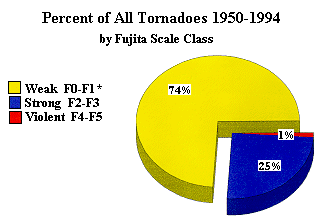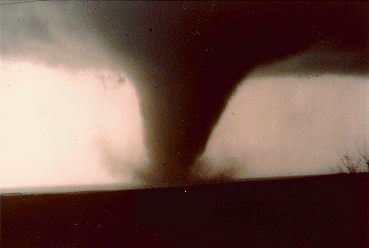The Fujita Scale is used to rate the intensity of a tornado by examining the damage caused by the tornado after it has passed over a man-made structure.
 The
"Percentage of All Tornadoes 1950-1994" pie chart reveals that the
vast majority of tornadoes are either weak or do damage that can only be
attributed to a weak tornado. Only a small percentage of tornadoes can be
correctly classed as violent. Such a chart became possible only after the
acceptance of the Fujita Scale as the official classification system for tornado
damage. It is quite possible that an even higher percentage of all tornadoes are
weak. Each year the National Weather Service documents about 1000 tornado
touchdowns in the United States. There is evidence that 1000 or more additional
weak tornadoes may occur each year and go completely undocumented.
The
"Percentage of All Tornadoes 1950-1994" pie chart reveals that the
vast majority of tornadoes are either weak or do damage that can only be
attributed to a weak tornado. Only a small percentage of tornadoes can be
correctly classed as violent. Such a chart became possible only after the
acceptance of the Fujita Scale as the official classification system for tornado
damage. It is quite possible that an even higher percentage of all tornadoes are
weak. Each year the National Weather Service documents about 1000 tornado
touchdowns in the United States. There is evidence that 1000 or more additional
weak tornadoes may occur each year and go completely undocumented.
 The
"Percentage of Tornado-Related Deaths 1950-1994" pie chart shows that
while violent tornadoes are few in number, they cause a very high percentage of
tornado-related deaths. The Tornado Project has analyzed data prior to 1950, and
found that the percentage of deaths from violent tornadoes was even greater in
the past. This is because the death tolls prior to the introduction of the
forecasting/awareness programs were enormous: 695 dead
(Missouri-Illinois-Indiana, March 18, 1925); 317 dead (Natchez, Mississippi, May
7, 1840);.255 dead (St. Louis, Missouri and East St. Louis, Illinois, May 27,
1896); 216 dead (Tupelo, Mississippi, April 5, 1936); 203 dead (Gainesville, GA,
April 6, 1936). In more recent times, no single tornado has killed more than 50
people since 1971.
The
"Percentage of Tornado-Related Deaths 1950-1994" pie chart shows that
while violent tornadoes are few in number, they cause a very high percentage of
tornado-related deaths. The Tornado Project has analyzed data prior to 1950, and
found that the percentage of deaths from violent tornadoes was even greater in
the past. This is because the death tolls prior to the introduction of the
forecasting/awareness programs were enormous: 695 dead
(Missouri-Illinois-Indiana, March 18, 1925); 317 dead (Natchez, Mississippi, May
7, 1840);.255 dead (St. Louis, Missouri and East St. Louis, Illinois, May 27,
1896); 216 dead (Tupelo, Mississippi, April 5, 1936); 203 dead (Gainesville, GA,
April 6, 1936). In more recent times, no single tornado has killed more than 50
people since 1971.
The Fujita Scale (also known as the Fujita-Pearson Scale) may not be a perfect
system for linking damage to wind speed, but it had distinct advantages over
what had gone on before its inception. And it was simple enough to use in daily
practice without involving much additional expenditure of time or money. From a
practical point of view, it is doubtful that any other system would have found
its way into widespread accepted use, even to this day. The entire premise of
estimating wind speeds from damage to non-engineered structures is very
subjective and is difficult to defend from various meteorological perspectives.
Nothing less than the combined influence and and prestige of the late Professor
Fujita and Allen Pearson, director of NSSFC (National Severe Storm Forecast
Center) in 1971 could have brought this much needed system into widespread use.
The FPP scale rates the intensity of the tornado, and measured both the path
length and the path width. The Fujita part of the scale is as follows:
The Fujita Scale
| F-Scale Number | Intensity Phrase | Wind Speed | Type of Damage Done |
| F0 | Gale | 40-72 | Some damage to chimneys; breaks branches off trees; pushes over shallow- rooted trees; damages sign boards. |
| F1 | Moderate | 73-112 | The lower limit is the beginning of hurricane wind speed; peels surface off roofs; mobile homes pushed off foundations or overturned; moving autos pushed off roads; attached garages may be destroyed. |
| F2 | Significant | 113-157 | Considerable damage. Roofs torn off frame houses; mobile homes demolished; boxcars pushed over; large trees snapped or uprooted; light object missiles generated. |
| F3 | Severe | 158-206 | Roof and some walls torn off well constructed houses; trains overturned; most trees in forests uprooted. |
| F4 | Devastating | 207-260 | Well-constructed houses leveled; structures with weak foundations blown off some distance; cars thrown and large missiles generated. |
| F5 | Incredible | 261-318 | Strong frame houses lifted off foundations and carried considerable distances to disintegrate; automobile sized missiles fly through the air in excess of 100 meters; trees debarked; steel reinforced concrete structures badly damaged. |
| F6* | Inconceivable | 319-379 | These winds are very unlikely. The small area of damage they might produce would probably not be recognizable along with the mess produced by F4 and F5 wind that would surround F6 winds. Missiles, such as cars and refrigerators would do serious secondary damage that could not be directly identified as F6 damage. If this level is ever achieved, evidence for it might only be found in some manner of ground swirl pattern, for it may never be identifiable through engineering studies. |
A key point to remember is this: the size of a tornado is not necessarily an indication of its intensity. Large tornadoes can be weak, and small tornadoes can be violent. A good example of a relatively "small" tornado would be the Pampa, Texas tornado of 1995, which can be seen in Tornado Video Classics III. This tornado is pictured on the right side of the slipcase, shown here. Notice the debris in the air. Eyewitnesses to this tornado claim to have seen as many as 6 vehicles in the air at the same time when it passed over a parking lot. Another consideration is the stage in the life cycle of the tornado. A "small" tornado may have been larger, and is at the "shrinking" stage of its life cycle, like the Tracy, Minnesota tornado on one of our posters, and also our logo, seen on the navigation bar to the left if you are using our frames. Large tornadoes can also be strong and small tornadoes can be weak. The Fujita Scale is based on damage, not the appearance of the funnel. Storm spotters, storm chasers and other weather observers often try to estimate the intensity of a tornado when they are in the field, basing their judgment on the rotational speed and amount of debris being generated as well as the width. However, the official estimate is made after the tornado has passed. Personnel from the National Weather Service office that issued the warning survey the site to determine the F-Scale rating. Sometimes they call in experts from out of the area. Aerial surveys are occasionally done after violent tornadoes to determine the exact damage track. Insurance companies may also call in wind engineers to do their own evaluations, but the official rating is set by the NWS. A few of the things they all look for are:
attachment of the walls and floor to the foundation of the building
| attachment of the roof to the rafters and walls
| whether or not there are steel reinforcing rods in concrete or cinder
block walls
| whether there is mortar between the cinder blocks | |
After the NWS office does the survey, the official rating is recorded, and eventually posted at the SPC site. If it is a killer tornado we also post the rating on our site with the description of the event, and on our "all tornadoes" page. The NWS office may also write up a more extensive report, which may or may not be posted on the web. A good example of such a report would be the one done on the Florida tornadoes of March, 1998.
The Fujita Scale is very subjective, and varies according to how experienced the surveyor is. We have many readers who have tried to do their own "surveys" of tornado damage when storms have occurred in their area. However, the less experienced the surveyor is, the more likely he/she is to be awed by the damage, and the more likely they are to give it a high rating. Brian Smith of the Omaha, Nebraska area NWS office, a former student of Dr. Fujita and an expert frequently brought in to do site surveys, tells of hearing about a tee-shirt with the words "F-3 My Foot" printed on it.
Media hype and inexperience with tornado damage also plays a big part in exaggerated F-Scale claims seen on television or in the paper. A reporter may see a collapsed concrete block home and be very impressed, never noticing that there was no mortar between the blocks. They may be aghast to see a park whose trees have been leveled, but not know that the species had very shallow roots, planted in soil that was soft and soggy from torrential rains, and thus easily toppled. They may see a roof that had been blown a quarter of a mile from its house, and not know that the roof was attached to the house with only a few nails, and when lofted into the air, acted as a "sail." They may see a light post that is bent at a 30 degree angle and think that it must have taken a 600 mph wind to do that, not knowing that a van had been blown into the pole, bending it, then been towed off to help clear the streets. For some of the media, the exaggerations make for a better story than the actual facts. Fortunately, they often make up for this by printing helpful stories about aid available and inspirational human interest stories.
As if doing a site survey of a track is not difficult enough, tornadic storms
may also be accompanied by complex combinations of strong downbursts and other
straight line winds. Separating tornado damage from other wind damage makes for
a daunting, difficult task for even the most experienced surveyor.

The Seymour, Texas, tornado of April 10, 1979 is a prime example of a tornado
that is destined to be misjudged on the Fujita Scale. This spectacular funnel
was probably capable of F4 damage, had it passed through a town. It produced
only telephone pole and tree damage, and thus could be rated no higher than F2
damage. The Seymour tornado was in the same family as the devastating Wichita
Falls. Texas tornado, which remains as of this writing, the most damaging
in US history. Video of this tornado is used in the Fujita Scale segment of
Tornado Video Classics II.
Professor Fujita continued his work until his
death at the age of 78. Mr. Pearson is semi-retired, and is very active on the
web.
![]()
*F6 ... I am going to prove to you all an F6 may have existed. Here are some links to the original pages, and in case they've been "killed off."
|







